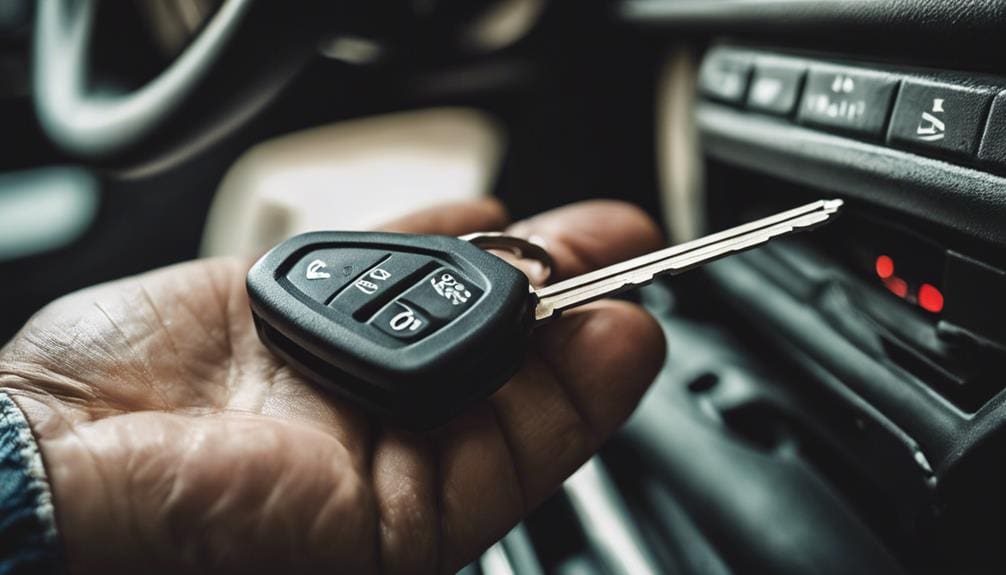Check your car manual for transponder chip details, then inspect your key. Look for a thicker plastic head or embedded RFID markings. Use a key programming tool to test for chip presence and functionality. Position the tool near the ignition and check for signal detection. Alternatively, consult a locksmith with advanced equipment for accurate identification. Understanding transponder chip technology, including brands like Texas Instruments and Philips/NXP, and their visual indicators, will aid in confirming your key’s specifications. To discover further intricacies and best practices, continue exploring this topic.
Key Takeaways
- Consult your car manual to check for anti-theft system details and transponder chip presence.
- Inspect your key for a thicker plastic head or embedded markings indicative of an RFID chip.
- Use key programming tools to test for the presence and functionality of the transponder chip.
- Look for visual indicators like a small plastic chip near the key blade or unusual thickness.
- Consult a locksmith with specialized equipment for accurate transponder chip identification.
Understanding Transponder Chips
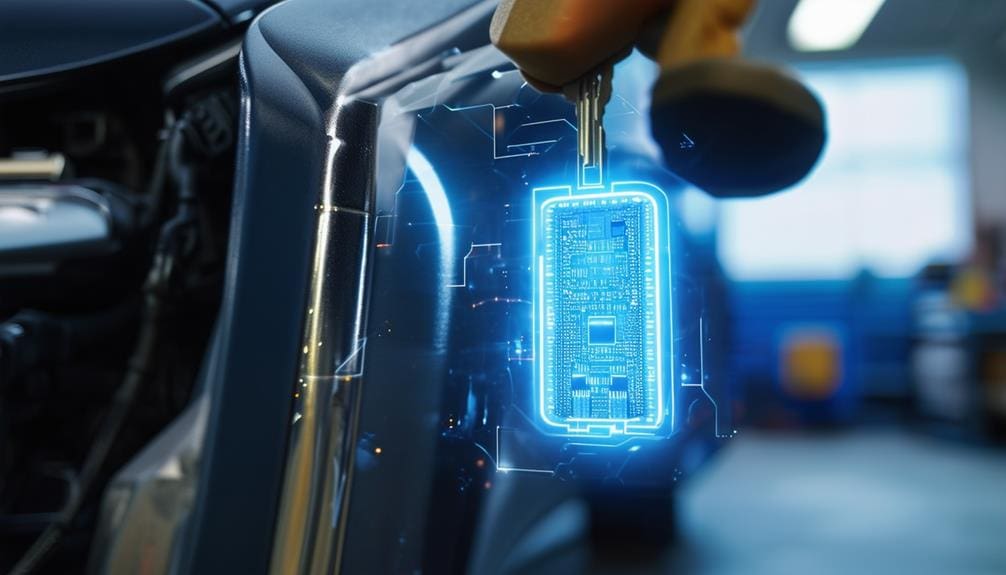
Transponder chips, often integrated within vehicle keys, function as critical components in modern automotive anti-theft systems. These microchips communicate with your car’s engine control unit (ECU), ensuring only authorized keys can start the engine. To understand transponder chips, you’ll need to grasp their operational mechanics. Each chip contains a unique serial number that’s transmitted to the ECU via a radio frequency identification (RFID) signal when the key is inserted into the ignition.
When you turn the key, an electromagnetic field activates the chip, prompting it to send its unique code. The ECU receives this code and compares it with stored data. If the code matches, the ECU disengages the immobilizer, allowing the engine to start. If there’s no match, the vehicle remains immobilized, effectively thwarting theft attempts.
To identify a transponder key, look for a plastic head that’s thicker than standard keys. This head houses the chip. Additionally, some keys may have visible markings or a small LED light indicating chip presence. Understanding these intricacies empowers you to make informed decisions about vehicle security, ensuring your car remains protected against unauthorized access.
Checking Your Car Manual
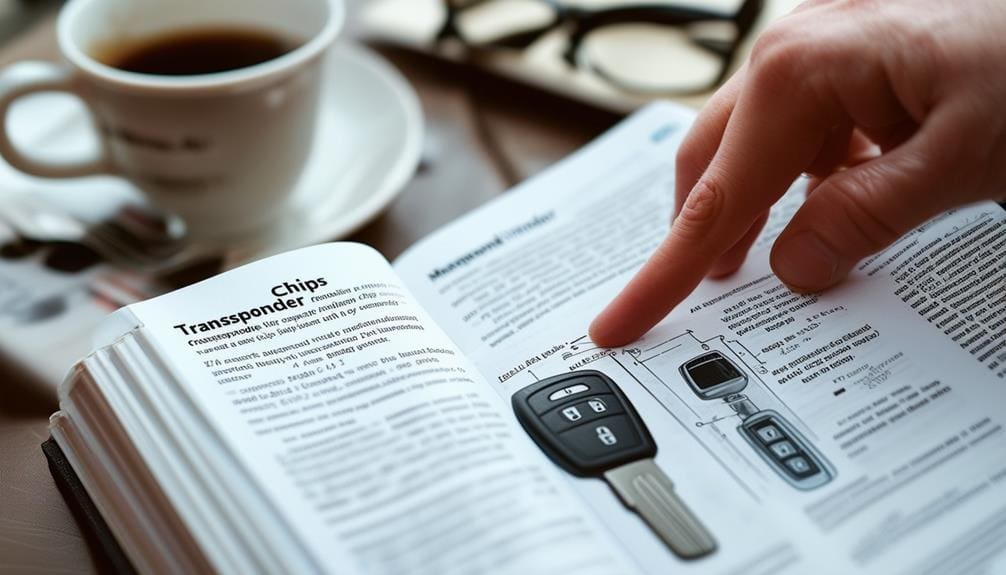
To verify the presence and specifications of a transponder chip in your vehicle’s key, consult your car manual where manufacturers often detail the anti-theft system components and their corresponding identification methods. Locate the section dedicated to the vehicle’s security system or keyless entry system. This segment typically outlines the technical aspects of the immobilizer system, including whether transponder technology is employed.
Once you’ve found the relevant section, scrutinize the terminology used. Look for keywords such as “transponder key,” “immobilizer,” “chip key,” or “RFID.” Manufacturers often list the specific model of the transponder chip used, including its frequency range, encryption standards, and operational protocols. Pay attention to any schematics or diagrams provided; these can offer visual confirmation of the transponder chip’s architecture and placement.
If your car manual includes a troubleshooting guide or FAQ section, review it for any references to the key’s electronic components. This can provide additional clues about the transponder system’s functionality, potential error codes, and diagnostic procedures. By leveraging the technical data presented in your car manual, you can ascertain whether your vehicle employs a transponder chip and understand its intricate specifications, ensuring you have thorough knowledge of your car’s security features.
Inspecting Your Key
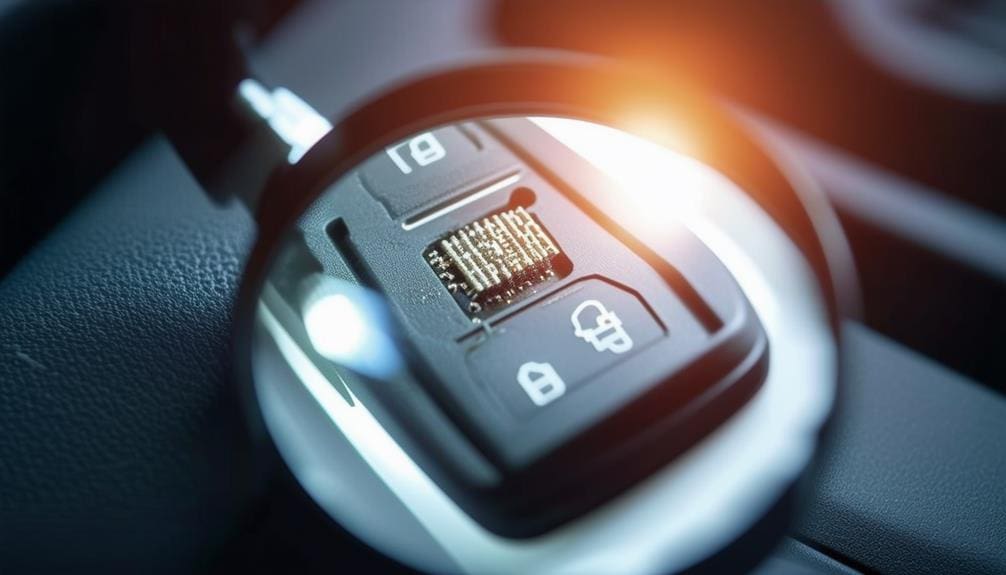
Begin by examining the key’s head for any visible signs of electronic components, such as embedded microchips or contact points. These indicators can confirm the presence of a transponder chip. Pay attention to the following characteristics:
- Plastic Casing: A thicker plastic head may house the transponder chip. Modern keys often incorporate a durable, molded plastic head to protect the internal components.
- Embedded Markings: Look for any imprints or engravings that hint at RFID technology. Common markings include serial numbers or manufacturer logos that denote transponder integration.
- Visible Components: Occasionally, you might notice a small, glass-encased microchip or metal contact points inside the key’s head. These elements are essential for the chip’s functionality.
Hold the key up to a bright light source. This can help you see through the plastic casing and identify any hidden components. If your key has a detachable plastic cover, carefully pry it open using a small screwdriver or similar tool to inspect the interior. However, exercise caution to avoid damaging the key’s integrity. By scrutinizing these features meticulously, you’ll be better equipped to determine if your vehicle key is embedded with a transponder chip, enhancing your vehicle’s security and ignition functionality.
Testing With Key Programming

After inspecting your key for a transponder chip, proceed to test its functionality through key programming methods. Begin by ensuring your vehicle is in a secure, controlled environment. Insert the key into the ignition and turn it to the ‘ON’ position without starting the engine. Observe the dashboard for any security indicator light. Typically, this light will illuminate and then turn off if the transponder chip is functioning correctly. If the light remains on or flashes, there may be an issue with the chip or its communication with the vehicle’s immobilizer system.
Next, utilize an OBD-II scanner with key programming capabilities. Connect the scanner to the vehicle’s OBD-II port, usually located under the dashboard. Follow the scanner’s prompts to navigate to the key programming section. This process may vary depending on the make and model of your vehicle, so consult the scanner’s manual for specific instructions. The device will attempt to communicate with the transponder chip. Successful communication confirms the presence and functionality of the chip. If the scanner fails to recognize the key, it could indicate a malfunction or the absence of a transponder chip.
Consulting a Locksmith

Given the complexity of transponder chip issues, seeking guidance from a professional locksmith can provide you with specialized expertise and advanced diagnostic tools. Locksmiths possess the technical acumen to identify whether your vehicle’s key contains a transponder chip without causing any damage or misconfiguration.
First, a locksmith will use advanced key analysis equipment to scan your key. This process involves sophisticated electronic diagnostic tools that can detect the presence and type of transponder chip embedded within the key.
Additionally, professional locksmiths have access to proprietary databases and manufacturer-specific information that can offer a higher level of insight into your vehicle’s security system. This means they can identify the exact specifications of your transponder chip, guaranteeing any replacements or programming are precisely matched to your vehicle’s requirements.
Seeking guidance from a locksmith can save you time and potential errors, as they can:
- Confirm chip presence: Use precision scanning tools to validate if a transponder chip exists.
- Determine chip type: Identify the specific transponder model and its frequency.
- Program new keys: Accurately clone or program new keys to match your vehicle’s security system.
Relying on a locksmith’s expertise ensures that your vehicle’s security is maintained and any transponder-related issues are resolved efficiently.
Using a Transponder Detector
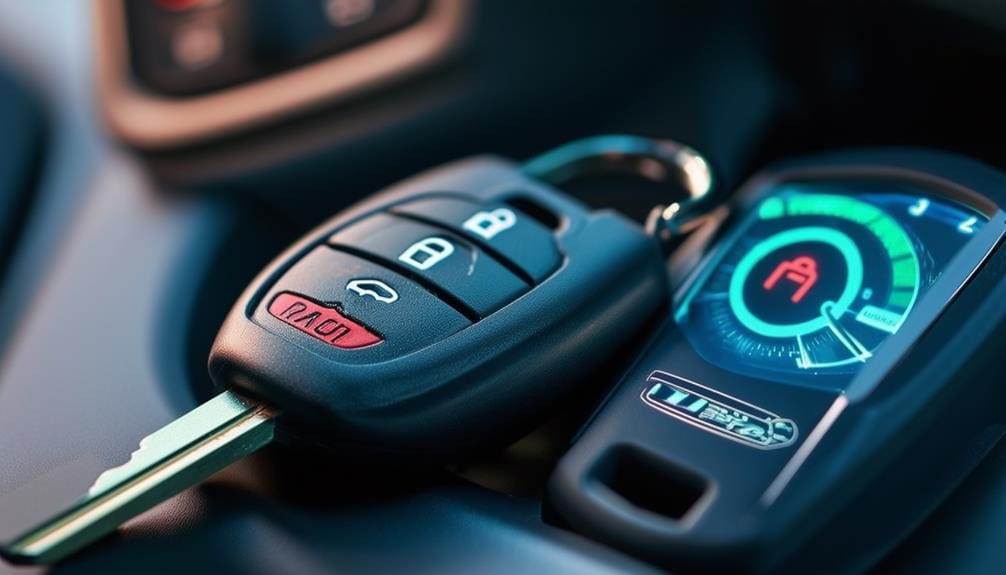
When using a transponder detector, first confirm that your device is compatible with the vehicle’s transponder frequency. Next, position the detector near the ignition switch and activate it to scan for the chip’s signal. Follow the on-screen prompts to identify and verify the presence of the transponder chip efficiently.
Detector Functionality Explained
To effectively identify transponder chips in vehicles, you’ll utilize a transponder detector that emits a low-frequency signal to activate and read the chip’s unique code. This device operates by sending out a specific radio frequency that triggers the transponder chip embedded in the car key or ignition system. Once activated, the chip transmits a signal back to the detector, which then processes and displays the code.
Understanding the functionality of your transponder detector is vital for accurate identification. The device typically consists of a handheld unit equipped with an antenna and a display screen. As you navigate through the detection process, the following features are paramount:
- Signal Emission: The detector emits a low-frequency signal, usually in the range of 125 kHz to 134 kHz, necessary for chip activation.
- Response Analysis: Upon receiving the chip’s return signal, the detector decodes the unique identifier and verifies its authenticity.
- User Interface: A clear and intuitive display allows you to read the unique code and provides real-time feedback on the detection status.
Step-by-Step Usage
Start by powering on your transponder detector and confirming the antenna is properly connected. Engage the device’s power switch, and check the battery levels are adequate. Position yourself near the vehicle’s ignition system, as the transponder chip is typically embedded in the key fob or ignition key.
Next, calibrate the detector by following the manufacturer’s instructions. This usually involves setting the device to a specific frequency range that matches your vehicle’s transponder system. Activate the scanning mode on your detector. Slowly move the antenna around the ignition area and key fob, maintaining a consistent distance of about one inch.
Observe the detector’s readout. A successful transponder detection will often trigger an audible beep or a visual indicator, such as an LED light. Note the signal strength and frequency data displayed; these metrics provide confirmation of the transponder chip’s presence.
If the detector fails to register a signal, reposition the antenna and repeat the scanning process. Ensure no metal objects or electronic devices interfere with the detector’s operation. Once you’ve confirmed the presence of a transponder chip, document the frequency and any relevant details for future reference. This guarantees precise future diagnostics and system compatibility checks.
Identifying Common Transponder Models
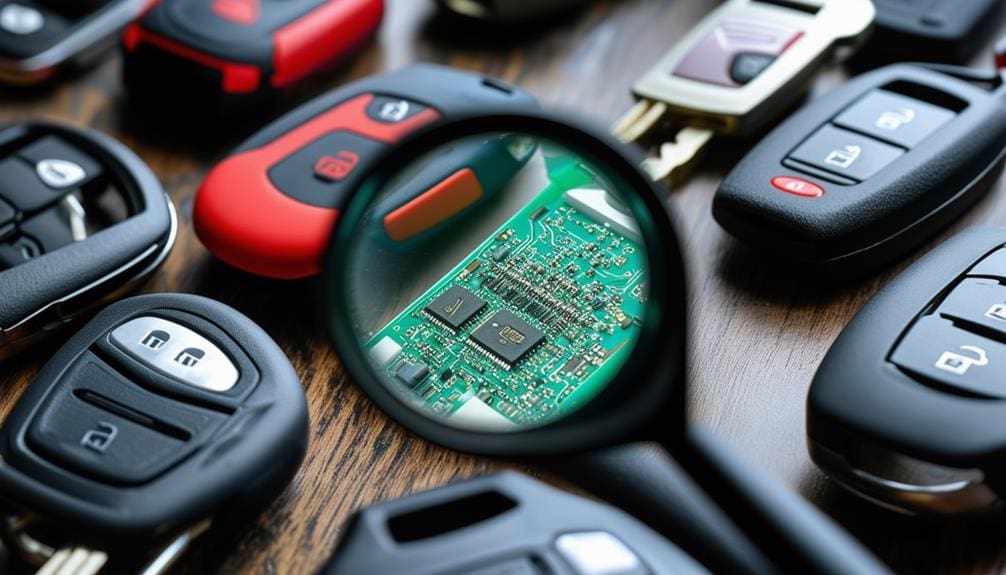
To begin identifying common transponder models, you’ll need to familiarize yourself with popular brands like Texas Instruments, Philips, and Megamos. Focus on visual chip identification by examining the module’s markings and structure. Understanding key programming basics will assist in recognizing how each model integrates with vehicle immobilizer systems.
Popular Transponder Brands
Among the most recognized transponder brands in the automotive industry, Texas Instruments, Megamos, and Philips stand out due to their widespread use and compatibility across a range of vehicle models. When you’re looking to identify a transponder chip in your car, knowing the brand can streamline the process significantly. Each of these brands has distinctive characteristics that can aid in rapid identification.
Texas Instruments’ transponders are typically found in Ford, Toyota, and Lexus vehicles. They are renowned for their TIRIS technology, which enhances signal strength and reliability. Megamos transponders, often used in Volkswagen, Audi, and BMW models, utilize Crypto transponder technology that prioritizes security through advanced encryption methods. Philips, now known as NXP Semiconductor, is prevalent in General Motors and Honda vehicles, leveraging their Hitag series for robust performance and security.
Key points to take into account:
- Texas Instruments (TIRIS): Found in Ford, Toyota, Lexus.
- Megamos (Crypto): Common in Volkswagen, Audi, BMW.
- Philips/NXP (Hitag): Used in General Motors, Honda.
Understanding these brands and their applications will empower you to quickly identify and work with the transponder chips in your vehicle, ensuring you achieve maximum control and efficiency in your automotive endeavors.
Visual Chip Identification
Having familiarized yourself with the leading transponder brands, you can now focus on visually identifying common transponder models by examining specific physical characteristics and design elements. Start by scrutinizing the key’s head for a small, often transparent or black plastic chip embedded within. This chip is typically located near the base, opposite the key blade.
Look for identifiers such as the presence of a small rectangular or square-shaped area, which may house the transponder. Brands like Texas Instruments often embed their chips in black epoxy resin, giving a distinct glossy finish. Philips transponders, on the other hand, might feature a visible microcircuit pattern, visible through a transparent enclosure.
Pay attention to the model numbers etched or stamped on the key’s head. These alphanumeric codes can provide valuable clues about the specific transponder type. For instance, Ford transponder keys might be labeled with “H72-PT” or “H84-PT,” indicating a specific chip model.
Examine the key’s structure for any unusual thickness or weight, as these can indicate the presence of a transponder. By understanding these physical traits, you can efficiently identify and differentiate between various transponder models, ensuring you have the precise information needed for further vehicle security assessments.
Key Programming Basics
Understanding the fundamentals of key programming starts with identifying common transponder models used by major automotive manufacturers like Ford, GM, and Toyota. These OEMs deploy various transponder technologies, making it essential to know which model you’re dealing with to guarantee seamless key programming and cloning.
First, familiarize yourself with the Philips Crypto (PCF7935AS), Texas Instruments (TMS37145), and Megamos Crypto (ID48). These transponders dominate the market and have distinct programming protocols. Identifying your car’s transponder model will allow you to choose the correct programming equipment and software, enhancing operational efficiency.
To pinpoint the transponder type, you can:
- Consult the vehicle’s manual: Manufacturers often list the transponder type in the key section.
- Use a diagnostic tool: Advanced OBD-II scanners can read the transponder’s ID and type directly.
- Inspect the key’s circuit board: Disassemble the key fob and look for identifying marks or numbers on the transponder chip.
Benefits of Professional Assistance

Enlisting expert assistance ensures that transponder chip identification and programming are carried out with precision, leveraging industry-grade tools and expertise. Professionals use advanced diagnostic equipment, such as EEPROM programmers and key cloning devices, ensuring accurate detection and flawless programming of your vehicle’s transponder chip. This minimizes the risk of errors that could compromise your car’s security system.
Technicians are knowledgeable in immobilizer systems, CAN bus communication protocols, and ECU/ECM interfacing, providing you with a thorough diagnostic and programming service. Their in-depth knowledge reduces the chance of damaging your vehicle’s electronic control units, saving you from costly repairs.
By choosing professional help, you also gain access to current software and firmware updates necessary for the latest vehicle models, which DIY methods might lack. Professionals often have direct access to OEM specifications and proprietary information that enhances the accuracy of their work.
Additionally, expert services include warranty and support, offering you peace of mind. If issues arise post-programming, you’ve got a safety net. Ultimately, professional intervention enhances your vehicle’s security, reliability, and functionality, giving you the power and confidence you seek in maintaining your vehicle’s integrity.
Frequently Asked Questions
Can Transponder Chips Be Deactivated or Removed From Car Keys?
Yes, you can deactivate or remove transponder chips, but it requires specialized equipment and technical expertise. Deactivation involves reprogramming the car’s ECU, while removal demands precision to avoid damaging the key’s internal circuitry.
How Much Does It Cost to Replace a Transponder Key?
Replacing a transponder key? Prepare your wallet for a joyride. You’re looking at $50-$250 depending on your car’s make, model, and year. Dealer prices are highway robbery, but locksmiths might offer a smoother ride.
Are Transponder Keys Waterproof or Resistant to Damage?
Transponder keys aren’t entirely waterproof but possess a degree of water resistance. To maintain peak functionality, avoid submersion and prolonged exposure to moisture. Handling with care guarantees the embedded RFID chip remains operational and responsive.
Can I Program a Transponder Key Myself Without Professional Help?
Programming a transponder key yourself isn’t a walk in the park. You’ll need a blank transponder key, your vehicle’s user’s manual, and an OBD2 scanner. Follow the manual’s specific steps, ensuring the key synchronizes with your car’s immobilizer system.
What Year Did Car Manufacturers Start Using Transponder Chips?
Car manufacturers began implementing transponder chips in the early 1990s, with widespread adoption by 1997. Check your vehicle’s model year; if it’s post-1997, it likely utilizes this advanced anti-theft technology for enhanced security.
Conclusion
In your quest to determine if your car key houses a transponder chip, you’ve explored a maze of technical checks and expert advice. Now, armed with your manual, key inspection, and possibly even a transponder detector, you’re practically a transponder-detecting superhero! Yet, the ultimate power move is consulting a locksmith—they’re like the wizards of the automotive world. So, immerse yourself and decode your key’s secrets with unparalleled precision and confidence!

